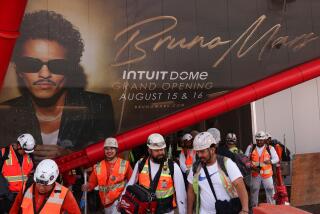Bigger is Better at Indian Wells
INDIAN WELLS — Evidently, the size of a tennis stadium does matter.
It explains how, on the face of it, a perfectly good facility was shown the door after 13 years, given its walking papers for a younger, prettier model just down the road.
What looked perfectly good wasn’t good enough for longtime tournament director Charlie Pasarell. Others might have been able to tolerate the flaws, the easy-to-hide blemishes, but not Pasarell.
He needed space and growth in the relationship.
So he pulled out of the Hyatt Grand Champions and moved down the road, less than two miles away, to the $75-million Indian Wells Tennis Garden, the new site of the Indian Wells Tennis Masters Series, which opens with first-round women’s play Friday. The new stadium, the second-largest tennis facility in the country, seats 16,100.
“People loved it still,” Pasarell said of the old digs. “But they didn’t even have to tell me. I could read it in their faces. I could see it. I could see people bumping into each other.”
He came to that realization long before the first shovel of dirt was turned more than a year ago.
Pasarell had looked like a trend-setter, a visionary, in 1987 when his tournament moved from a tranquil setting at La Quinta to a new 11,500-seat stadium at the Hyatt Grand Champions.
But in sports, yesterday’s visionary becomes, well, yesterday, if he stands still.
Pasarell read the body language of the fans and listened to the concerns of the players.
And other promoters were raising the bar. His friendly rival, Butch Buchholz, had created a formidable event in South Florida, the tournament now known as the Ericsson Open. His main stadium, seating 14,000 spectators, was voted the best by Tennis magazine in 1997.
The U.S. Open was finally getting its act together, completing a well regarded remodeling, and internationally, a couple of sleepy giants were stirring. Next year, the Australian Open will unveil a 10,000-seat second court with a retractable roof, one that closes twice as fast as Centre Court.
“[Grand Champions] still happens to be one of the 10 best stadiums anywhere in the world,” Pasarell said. “We really were out of space. I actually wish I could pick up that stadium and make it my No. 2 stadium. It’s still a magnificent stadium. But we needed to grow. We needed to expand.
“It wasn’t major league. . . . Key Biscayne did it first. The U.S. Open. What is the French Open doing now? They’re doing a major remodeling of their Stadium Court. A total remodel. This spurred a lot of people, saying, ‘Whoa, we’ve got to build a major league facility.’ ”
Although he realized as long as eight years ago that he would have to move, Pasarell really started feeling restless about four years ago, giving himself a deadline of 2000 for a new site. His company, PM Sports, formed a partnership with IMG, the sports management firm, and the city of Indian Wells paid $2.5 million for the stadium’s naming rights in a 10-year deal.
“We’ll probably be the poster child for fast-tracking in Riverside County,” said former Indian Wells mayor Richard Oliphant of the 17-month construction process, which included 40 subcontractors.
Oliphant was speaking at the grand opening of the facility last Wednesday. Pasarell, his business partner Ray Moore and tennis legend Rod Laver initiated the stadium court by all hitting serves at the same time.
Laver raved about the facility, saying, “This just proves to everybody that tennis is here to stay and it’s doing well. You’ve got great champions in [Pete] Sampras and [Andre] Agassi. You’ll see great tennis.”
Pasarell hired the same architects who worked on the U.S. Open remodeling, as well as the Buchholz project at Key Biscayne, Fla., and spectators will notice similarities. Of course, the view from the top of the stadium at Indian Wells won’t make you dizzy, as it does at the U.S. Open.
“I have the benefit of Butch Buchholz, and all the USTA people,” Pasarell said. “We’re the third generation. When I saw what they were doing, it’s easy to copy things. . . . There are a lot of things I stole from Paul Flory [in Cincinnati].”
Pasarell amended that, saying, “Ideas that I borrowed.”
One of the bigger problems at the old site was seating at the secondary courts. At this year’s event, eight courts will be used for competition. The secondary show courts, No. 2 and No. 3, will seat about 5,000 and 3,000 fans, respectively. Courts 4-8 will seat 500-1,500.
The lack of practice courts used to be a big problem, especially once the women’s event gained in prominence. Sampras previously noted he wasn’t able to practice as much during the combined event.
That, most likely, will not be a problem now, since 12 other courts are already available on the 50-acre complex for practice. The players’ area is multilevel, the 11,000 square-foot lower level including a lobby and locker rooms.
“We definitely take notice, especially when they improve the locker-room facilities,” Sampras said. “Charlie wanted to make it better, and certainly has done that from what I hear. I’m looking forward to seeing it and playing in a new stadium, since I haven’t had too much luck there.”
Inside the locker room is a smaller dressing space for former champions. Sampras, despite his recent struggles at Indian Wells, has won here in 1994 and 1995. One glitch was recently discovered on a walk-through of the room for former champions. Two lamps were hanging too low, putting players in danger of head-banging collisions.
Such problems are expected to be resolved before the tournament starts.
Pasarell is pleased with another feature, a meditation room, for lack of a better name. “I wished when I were playing, there was a private lounge where a player could sit and relax and not be bothered by anybody two hours before he plays his match,” he said. “There isn’t a stadium in the world that a player can find that place. They have to lay down on the locker-room floor or at a trainer’s table, if it is empty.”
His experience as a player and a tournament director has helped him in this latest venture. And so did his experience at Hyatt Grand Champions. The stadium court at the Grand Champions is still standing but will be torn down to make room for more villas and a bigger spa.
As for the new site, Pasarell has left plenty of room for expansion.
“It would be a crime if we didn’t use [the stadium] for other things,” he said. “We’re working to put together a full schedule of events. We have a lot of things in the works, irons in the fire.”
(BEGIN TEXT OF INFOBOX / INFOGRAPHIC)
INDIAN WELLS TENNIS GARDEN
* Cost: $75 million.
* Stadium capacity: 16,100.
* Luxury suites: 44.
* Surface: Hard court.
* Other show courts: Courts 2 and 3 have temporary seating of 5,000 and 3,000. Courts 4-8 seat 500 to 1,500. The 50-acre complex offers 20 courts.
More to Read
Go beyond the scoreboard
Get the latest on L.A.'s teams in the daily Sports Report newsletter.
You may occasionally receive promotional content from the Los Angeles Times.











